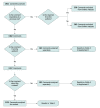Characterization of Comments About bioRxiv and medRxiv Preprints
- PMID: 37647065
- PMCID: PMC10469270
- DOI: 10.1001/jamanetworkopen.2023.31410
Characterization of Comments About bioRxiv and medRxiv Preprints
Abstract
Importance: Preprints have been increasingly used in biomedical science, and a key feature of many platforms is public commenting. The content of these comments, however, has not been well studied, and it is unclear whether they resemble those found in journal peer review.
Objective: To describe the content of comments on the bioRxiv and medRxiv preprint platforms.
Design, setting, and participants: In this cross-sectional study, preprints posted on the bioRxiv and medRxiv platforms in 2020 were accessed through each platform's application programming interface on March 29, 2021, and a random sample of preprints containing between 1 and 20 comments was evaluated independently by 3 evaluators using an instrument to assess their features and general content.
Main outcome and measures: The numbers and percentages of comments from authors or nonauthors were assessed, and the comments from nonauthors were assessed for content. These nonauthor comments were assessed to determine whether they included compliments, criticisms, corrections, suggestions, or questions, as well as their topics (eg, relevance, interpretation, and methods). Nonauthor comments were also analyzed to determine whether they included references, provided a summary of the findings, or questioned the preprint's conclusions.
Results: Of 52 736 preprints, 3850 (7.3%) received at least 1 comment (mean [SD] follow-up, 7.5 [3.6] months), and the 1921 assessed comments (from 1037 preprints) had a median length of 43 words (range, 1-3172 words). The criticisms, corrections, or suggestions present in 694 of 1125 comments (61.7%) were the most prevalent content, followed by compliments (n = 428 [38.0%]) and questions (n = 393 [35.0%]). Criticisms usually regarded interpretation (n = 286), methodological design (n = 267), and data collection (n = 238), while compliments were mainly about relevance (n = 111) and implications (n = 72).
Conclusions and relevance: In this cross-sectional study of preprint comments, topics commonly associated with journal peer review were frequent. However, only a small percentage of preprints posted on the bioRxiv and medRxiv platforms in 2020 received comments on these platforms. A clearer taxonomy of peer review roles would help to describe whether postpublication peer review fulfills them.
Conflict of interest statement
Figures



References
-
- Biology preprints over time. ASAPbio. Accessed March 3, 2023. https://asapbio.org/preprint-info/biology-preprints-over-time
-
- Sever R, Roeder T, Hindle S, et al. . bioRxiv: the preprint server for biology. bioRxiv. Preprint posted online November 6, 2019. doi:10.1101/833400 - DOI
-
- Dolgin E. PubMed Commons closes its doors to comments. Nature. February 2, 2018. doi:10.1038/d41586-018-01591-4 - DOI

